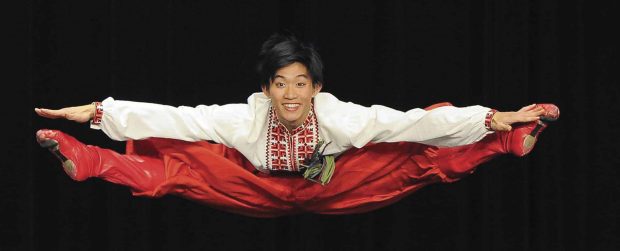
Lawrence Chen ’20 knows how to raise the barre. A ballet dancer since the age of 13, Chen is able to balance his professional dancing career while also being a full-time student majoring in chemistry. This April, Chen saw his first co-authored academic article published in a prestigious chemistry journal—a major achievement for any undergraduate student. The publication of the article is the grand finale for Chen, who spent two years doing research with Professor of Chemistry Roberto Garza-López. To understand how Chen is able to rehearse for 15-plus hours (sometimes up to 40 hours a week during performance season) and do graduate-level computational chemistry research, put yourself in his ballet slippers…
 Grow up listening to your mother share stories of studying ballet in Hong Kong—and how she had to give up a career in dance to support her family.
Grow up listening to your mother share stories of studying ballet in Hong Kong—and how she had to give up a career in dance to support her family.
 Own a DVD of the American Ballet Theatre’s 1977 production of “The Nutcracker” starring Mikhail Baryshnikov and Gelsey Kirkland and watch it over and over.
Own a DVD of the American Ballet Theatre’s 1977 production of “The Nutcracker” starring Mikhail Baryshnikov and Gelsey Kirkland and watch it over and over.
 Begin to study ballet at age 13—an “extremely late” start. Decide to be home-schooled for high school courses in order to allow time to study ballet intensely at a small ballet academy.
Begin to study ballet at age 13—an “extremely late” start. Decide to be home-schooled for high school courses in order to allow time to study ballet intensely at a small ballet academy.
 In addition to home-schooling, attend your local community college part time and take almost enough math classes to get an associate’s degree in the subject.
In addition to home-schooling, attend your local community college part time and take almost enough math classes to get an associate’s degree in the subject.
 Participate in large competitions, like the International Ballet Competition and Prix de Lausanne, to have a chance at scholarships to ballet companies with international prestige. Learn from both your successes and your losses to work even harder.
Participate in large competitions, like the International Ballet Competition and Prix de Lausanne, to have a chance at scholarships to ballet companies with international prestige. Learn from both your successes and your losses to work even harder.
 Get accepted to a number of colleges—including the University of Southern California for its dance program—but choose Pomona for its small classes and close-knit community.
Get accepted to a number of colleges—including the University of Southern California for its dance program—but choose Pomona for its small classes and close-knit community.
 In your first year, enroll in a ballet class taught by Victoria Koenig, director of the Inland Pacific Ballet dance company. Get invited to audition and dance in productions of “The Nutcracker” two years in a row.
In your first year, enroll in a ballet class taught by Victoria Koenig, director of the Inland Pacific Ballet dance company. Get invited to audition and dance in productions of “The Nutcracker” two years in a row.
 Take general chemistry courses and find a supportive mentor in Professor of Chemistry Roberto Garza-López, who attends a performance of “The Nutcracker” to see you dance.
Take general chemistry courses and find a supportive mentor in Professor of Chemistry Roberto Garza-López, who attends a performance of “The Nutcracker” to see you dance.
 Spend your first two summers on campus, thanks to grants from Pomona and the Howard Hughes Medical Institute (HHMI), conducting computational chemistry research for Garza-López.
Spend your first two summers on campus, thanks to grants from Pomona and the Howard Hughes Medical Institute (HHMI), conducting computational chemistry research for Garza-López.
 As a co-author, see your data published in Chemical Physics Letters: X, a peer-reviewed chemistry journal, during your junior year while starting rehearsals for a production of “The Little Mermaid.”
As a co-author, see your data published in Chemical Physics Letters: X, a peer-reviewed chemistry journal, during your junior year while starting rehearsals for a production of “The Little Mermaid.”
—Photo by Siggul/VAM
